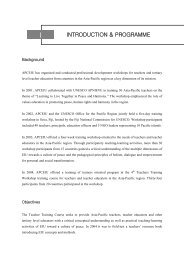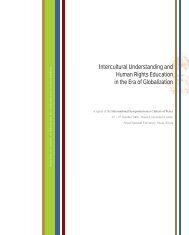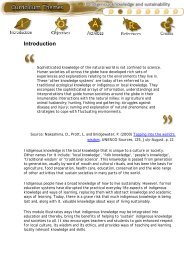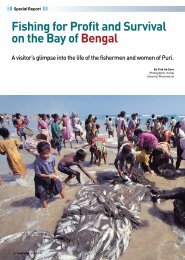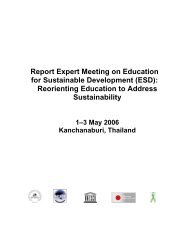Module 9 Consumer education - APCEIU
Module 9 Consumer education - APCEIU
Module 9 Consumer education - APCEIU
You also want an ePaper? Increase the reach of your titles
YUMPU automatically turns print PDFs into web optimized ePapers that Google loves.
The American Footprint ...<br />
Estimates for the year 1995, for example, which are based on the<br />
most recent publicly accessible United Nations statistics, show that<br />
the average American required approximately 24 acres (or 9.6<br />
hectares) to provide for his or her consumption expressed in the<br />
common unit of 'bioproductive space with world average<br />
productivity'. This space totals over 9 hectares of biologically<br />
productive land and 0.1 hectare of ecologically productive sea space.<br />
These 24 acres or 9.6 hectares correspond to 96,000 sq. metres<br />
(960 times 100 ms) or 24 football fields.<br />
... Compared To The Available Eco-capacity<br />
Dividing all the biologically productive land and sea on this planet by<br />
the number of people inhabiting it results in an average of 2.1<br />
hectares (5.2 acres) existing per person in 1999. This capacity per<br />
capita is less than a quarter of what is necessary to accommodate<br />
the 9.6 hectares footprint of an average American. Of these 2.1<br />
hectares per person, 1.6 are land based natural and managed<br />
ecosystems such as forests, pastures and arable land; 0.5 hectares<br />
are ecologically productive ocean areas most of which are located on<br />
continental shelves.<br />
However, there is a slight complication. People should not use all the<br />
2.1 hectares per capita since we are not alone on this planet. We<br />
share it with over 10 million other species - most of whom are<br />
excluded from the spaces we occupy so intensively for human<br />
purposes. For example, industrial agriculture calls 'weed' any species<br />
that is not exploitable, and for urbanization, much of the most<br />
fertile land is just paved over. How much of the bio-productive area<br />
should we leave relatively untouched for these other 10 million<br />
species How much would be fair How much would you feel is<br />
necessary to secure an ecologically stable world<br />
Having personally asked many people, I have met only a few who think<br />
we should leave less than one third of the eco-capacity for the many<br />
other species whom we typically exclude through our practices. To be<br />
even more generous to the human species and make sure that our<br />
analysis does not exaggerate the ecological scarcity of today, we<br />
follow the politically courageous, but ecologically insufficient<br />
suggestion by the Brundtland Report: Our Common Future (1987). Its<br />
authors invited the world community to protect 12% of the<br />
biologically productive space for preserving the other 10 million<br />
species with whom we share this planet. Using this conservative<br />
number, the available bio-productive space per person shrinks from



